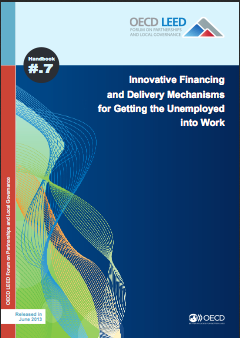This paper describes innovative financing and delivery mechanisms for getting long-term unemployed people back into work. Finance can be innovative especially when it comes from non-public sources, when it is not grant based or when it is applied to structure the delivery system in a new way. Certain types of finance might draw on all of these approaches. In this working paper we understand normal financing to be financing paid for out of taxation that pays for inputs in the expectation that positive outputs and policy outcomes will be secured. This type of output finance operates between parts of government, for instance from central to regional or local government, or from national treasuries to individual departments. Other ways of distributing input-based funding include grant programmes such as EU Structural Funds.
Having examined the challenges which drive the interest in new forms of financing in Section 1, Section 2 goes on to explore different forms of innovative finance ranging from social investing, which is growing rapidly and includes new initiatives like the United Kingdom’s Big Society Capital, microfinance which uses social collateral to invest in self-employment, the use of “invest to save” approaches, using public procurement and new forms of crowd and peer to peer finance that work through social media.
Section 3 explores methods of delivering, including how to finance large numbers of micro projects, and and decentralising financing to the local level.
Section 4 explores how finance and delivery models can be combined using payment by results and social impact bonds as illustrations. In payment by results, the payments are back loaded and the service provider has to find some type of bridging capital to finance their inputs. These techniques can be mixed in complex financial instruments, such as the much-heralded social impact bond, which brings in private financing to invest in a public service and where the rewards to investors are calibrated to be higher when specified outcomes are achieved.
Contents
1. Introduction
1.1. Drivers of innovation
1.2. The problem that new financial approaches try to solve
2. Innovative sources of finance
2.1. Social investing: A source of new ideas
2.2. Moving from grants to loans
2.3. Supporting self-employment through microfinance
2.4. Invest to save approaches
2.5. Money from unusual sources: Being creative about procurement
2.6. Financing through social media, peer to peer and crowd funding
3. Adapting the delivery system
3.1. Reaching the parts that larger programmes cannot reach: Delivering micro-projects
3.2. Decentralising employment services to the municipal level
4. Combining new finance with new delivery models
4.1. Payment by results
5. Conclusions: Towards a new and more complex landscape of financial models for long-term unemployment
Notes
Bibliography





